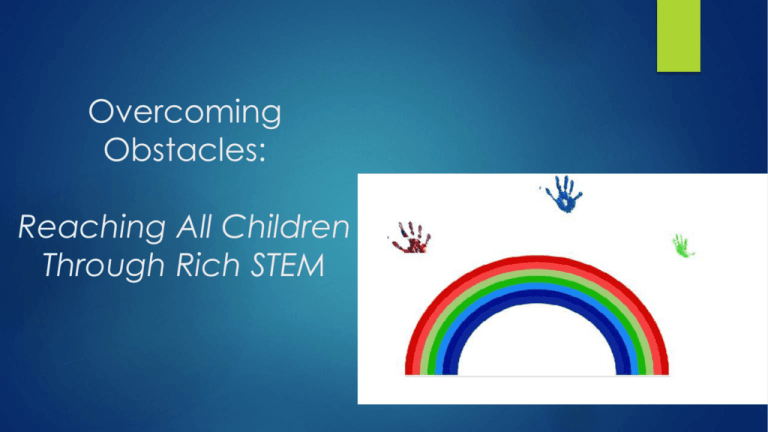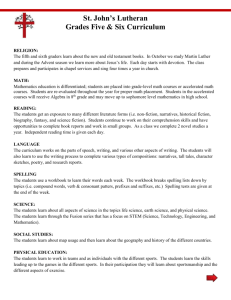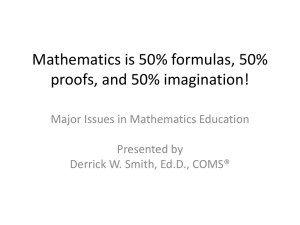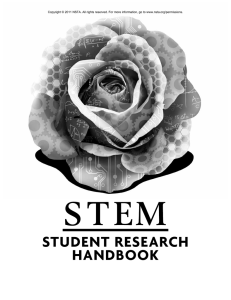Integrating authentic, interesting and relevant learning
advertisement

Overcoming Obstacles: Reaching All Children Through Rich STEM Before we talk about achievement gaps, let’s look at a couple of success stories MODEL PROGRAMS ALL OVER THE NATION HAVE ACHIEVED GREAT RESULTS. THE KEY IS TO ANALYZE WHAT THEY HAVE IN COMMON. Local Initiatives Show: Integrating authentic, interesting and relevant learning (especially in STEM) with language has strong results. Student Gains Gain S.E. Vocabulary Treatment 0.69 0.086 *** Control 0.39 0.079 *** Cleveland, Ohio Mathematics and Science Partnership: Science and Literacy Project Integrating language arts and science in inner city schools, the Seeds of Science/Roots of Reading program led to higher student performance on assessments of science knowledge, vocabulary, and writing. Teachers also found the program usable, effective, and engaging. Reading Treatment 2.38 0.104 *** Control 1.18 0.090 *** *** p < .01, ** p <.05, * p< .10 2.5 2 1.5 Vocabulary Goldschmidt, P., and Jung, H. (2010). Evaluation of Seeds of Science/Roots of Reading: Effective Tools for Developing Literacy through Science in the Early Grades (PDF). Reading 1 0.5 0 Integrated Taught Alone Texas Turnaround for At Risk Students In 2012 the Texas basic skills tests changed. All districts saw a drop. This graph compares improvements in 2013 for at risk students in basic skills for the entire state (black) and four districts that embedded their mathematics and science instruction into STEM/Citizen Science through JASON Learning. Southwest Schools/Texas Closing the Achievement Gap Reading This district integrated middle level Citizen Science with language acquisition in 2013. They found strong gains for economically disadvantaged, White, Hispanic, African American, and All Students. “Although STEM is specific for fields of study in science, technology, engineering, and mathematics, we realize the significance of literacy (Reading) in the success of all subjects for our students.” ELL Economically… SPED White 2013 Hispanic 2012 African American All Students 0 20 40 60 80 100 Student Achievement for STAAR 8th grade math Numbers, Operations,… 0 10 20 30 40 50 60 % of students scores for the STAAR 8th grade math 2013 2012 When we teach science, we are also teaching English, not just teaching in English. Opportunities and Challenges for ELLs in the Science Inquiry Classroom (Part 1) Rusty Bresser and Sharon Fargason (2014) The use of guided inquiry (beginning with a more structured approach and then gradually developing to a more open-ended approach to learning) that builds on students’ prior knowledge and science content provides English language learners with opportunities to learn the practice of science (Amaral, Garrison, and Klentschy 2002; Fradd and Lee 1999; Vanosdall et al. 2007; Warren and Rosebery 2008). NSTA Position Science for English Language Learners http://www.nsta.org/about/positions/ell.aspx But in most communities the path to such progress is illusive. What will make a program work? How do individual districts find models? Empowerment [NGSS] PRACTICES MAKE PERFECT…paths to literacy 1. Asking questions (for science) and defining problems (for engineering) 2. Developing and using models 3. Planning and carrying out investigations 4. Analyzing and interpreting data 5. Using mathematics and computational thinking 6. Constructing explanations (for science) and designing solutions (for engineering) 7. Engaging in argument from evidence 8. Obtaining, evaluating, and communicating information Enfranchisement STUDENTS MUST BEGIN TO SEE THEMSELVES AS ENTITLED TO BECOME SCIENTISTS, NOT AS OBSERVERS. THEY MUST BE MENTORED TO BELIEVE IN THEMSELVES. CULTURALLY RELEVANT ROLE MODELS ARE VITAL. SO ARE NON-SCIENTISTS WHO TELL THEM THEY CAN. Key idea from successful programs: Reading and mathematics taught in the context of science are more effective than when taught in isolation. The practices of science are not simply tools for experimenting; they enable students to solve problems in all areas of their lives. Lessons must have personal and cultural relevance Lessons must extend to problem solving (engineering integration) Language, reading and mathematics are learned most quickly when they are in relevant contexts. Reading and mathematics scores go up when the skills are learned in context When students see themselves as problem-solvers, they are able to see themselves as success. Culturally relevant role models Involvement of the community Barriers in average schools: Siloing The perception that language must be taught intensively and separately Top-Down attitude toward curriculum development Lack of access to appropriate facilities and materials Lack of culturally-appropriate role models and literature Lack of cultural sensitivity Lack of ammunition! To change school cultures, we must empower teachers and administrators as well. We must look carefully at the factors in their positions for which they are rewarded, and make sure they are coherent with what we want in the end. From NSTA’s Learning Center, a community of over 450,000 educators each year, we hear real stories of promise, practice and problems: •High emphasis on testing--only the middle students get attention •Lack of facilities to do authentic (STEM) learning safely (especially for students with limited language facility) •Little access to information on cultural differences •Examples: Reluctance to participate in scientific argumentation •Cultural traditions that may conflict with scientific investigations •No trade books that are culturally relevant •Few culturally relevant role models or real historical background But we hope to do better! Next month NSTA brings together representatives from a dozen national educational groups to chart a path toward a nationally accessible database so that barriers can be overcome. Ideas? Questions? www.nsta.org





